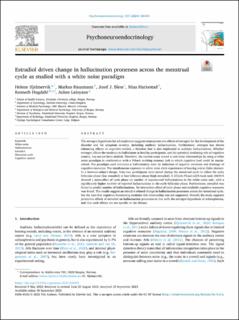| dc.contributor.author | Hjelmervik, Helene | |
| dc.contributor.author | Hausmann, Markus | |
| dc.contributor.author | Bless, Josef J. | |
| dc.contributor.author | Harkestad, Nina | |
| dc.contributor.author | Hugdahl, Kenneth Jan | |
| dc.contributor.author | Laloyaux, Julien | |
| dc.date.accessioned | 2024-01-23T12:16:25Z | |
| dc.date.available | 2024-01-23T12:16:25Z | |
| dc.date.created | 2023-10-12T10:26:00Z | |
| dc.date.issued | 2023 | |
| dc.identifier.citation | Psychoneuroendocrinology. 2023, 159 . | en_US |
| dc.identifier.issn | 0306-4530 | |
| dc.identifier.uri | https://hdl.handle.net/11250/3113336 | |
| dc.description.abstract | The estrogen hypothesis for schizophrenia suggests neuroprotective effects of estrogen for the development of the disorder and for symptom severity, including auditory hallucinations. Furthermore, estrogen has shown enhancing effects on cognitive control, a function that is also implicated in auditory hallucinations. Whether estrogen affects the tendency to hallucinate in healthy participants, and the potential mediating role of cognitive control, has not yet been studied. Therefore, the current study aimed to test these relationships by using a white noise paradigm in combination with a N-back working memory task in which cognitive load could be manipulated. The paradigm used simulates a hallucinatory state by induction of negative emotions and drainage of cognitive resources. The simultaneous exposure to white noise elicit experiences of hearing voices (false alarms). In a between-subject design, forty-two participants were tested during the menstrual cycle in either the early follicular phase (low estradiol) or late follicular phase (high estradiol). A 2(Cycle Phase) x2(N-back task) ANOVA showed a main-effect of cycle phase on number of experienced hallucinations in the white noise task, with a significantly higher number of reported hallucinations in the early follicular phase. Furthermore, estradiol was found to predict number of hallucinations. No interaction effect of cycle phase and available cognitive resources was found. The results suggest an estradiol-related change in hallucination proneness across the menstrual cycle, but the idea that cognitive functioning mediates this relationship was not supported. Overall, the study supports protective effects of estradiol on hallucination proneness in line with the estrogen-hypothesis of schizophrenia, and that such effects are not specific to the disease. | en_US |
| dc.language.iso | eng | en_US |
| dc.rights | Navngivelse 4.0 Internasjonal | * |
| dc.rights.uri | http://creativecommons.org/licenses/by/4.0/deed.no | * |
| dc.subject | White-noise | en_US |
| dc.subject | Hallucinations | en_US |
| dc.subject | Estradiol | en_US |
| dc.subject | Menstrual cycle | en_US |
| dc.subject | Cognitive control | en_US |
| dc.title | Estradiol driven change in hallucination proneness across the menstrual cycle as studied with a white noise paradigm | en_US |
| dc.title.alternative | Estradiol driven change in hallucination proneness across the menstrual cycle as studied with a white noise paradigm | en_US |
| dc.type | Peer reviewed | en_US |
| dc.type | Journal article | en_US |
| dc.description.version | publishedVersion | en_US |
| dc.source.pagenumber | 8 | en_US |
| dc.source.volume | 159 | en_US |
| dc.source.journal | Psychoneuroendocrinology | en_US |
| dc.identifier.doi | 10.1016/j.psyneuen.2023.106410 | |
| dc.identifier.cristin | 2184021 | |
| dc.source.articlenumber | 106410 | en_US |
| cristin.ispublished | true | |
| cristin.fulltext | original | |
| cristin.qualitycode | 2 | |

